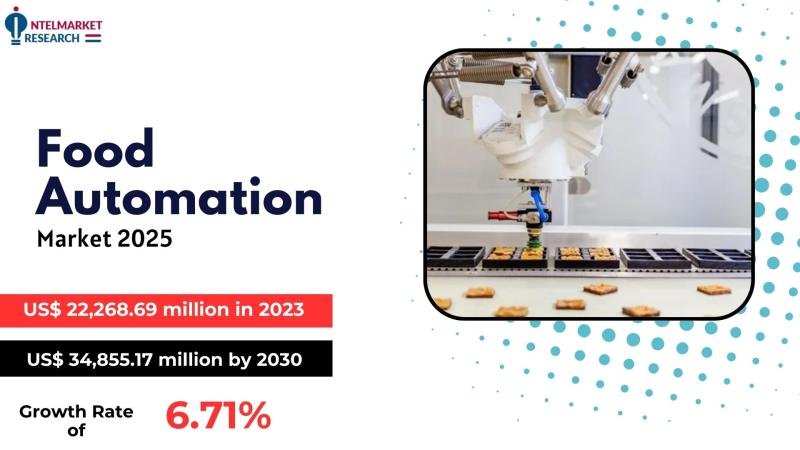
The global Food Automation market was valued at US$ 22,268.69 million in 2023 and is projected to reach US$ 34,855.17 million by 2
Food Automation refers to the integration of automated systems, robotics, and advanced technologies in the food and beverage industry to improve efficiency, precision, and safety in production, processing, packaging, sorting, and quality control. These technologies help manufacturers reduce operational costs, enhance product quality, and meet the growing demand for food products globally. Key applications include automated assembly lines, robotic processing units, and smart quality control systems.
➣ Market Size
Report Sample includes:
– Table of Contents
– List of Tables & Figures
– Charts
– Research Methodology
Get FREE Sample of this Report at https://www.intelmarketresearch.com/download-free-sample/216/food-automation
The global Food Automation market was valued at US$ 22,268.69 million in 2023 and is projected to reach US$ 34,855.17 million by 2030, growing at a CAGR of 6.71% during the forecast period of 2024-2030.
➣ Key Statistics:
North America: Valued at US$ 5,177.47 million in 2023, it is expected to grow to US$ 6,629.09 million by 2030, at a CAGR of 3.41%.
Asia-Pacific: This region is set to experience the fastest growth, increasing from US$ 8,644.71 million in 2023 to US$ 15,513.88 million by 2030, at a robust CAGR of 9.15%.
Top three global players contributed approximately 26.38% of the total revenue in 2023, indicating a moderately concentrated market.
North America: Valued at US$ 5,177.47 million in 2023, it is expected to grow to US$ 6,629.09 million by 2030, at a CAGR of 3.41%.
Asia-Pacific: This region is set to experience the fastest growth, increasing from US$ 8,644.71 million in 2023 to US$ 15,513.88 million by 2030, at a robust CAGR of 9.15%.
Top three global players contributed approximately 26.38% of the total revenue in 2023, indicating a moderately concentrated market.
➣ Market Dynamics
➣ Drivers
Rising Demand for Processed Foods: Increasing consumer preference for ready-to-eat meals and packaged food is driving the adoption of automated systems for faster production and consistent quality.
Labor Shortages and High Wages: Automation addresses the issue of labor shortages and mitigates the rising costs associated with human labor in food manufacturing.
Enhanced Food Safety Regulations: Automation ensures compliance with stringent food safety standards, reducing human error and contamination risks.
Technological Advancements: The integration of AI, IoT, and robotics has revolutionized food automation, enabling predictive maintenance, real-time monitoring, and efficient resource utilization.
➣ Restraints
High Initial Investment: Setting up automated systems requires significant capital, which can be a barrier for small and medium enterprises.
Complex Integration: The challenge of integrating automated systems with existing production lines may deter some companies from adopting these technologies.
➣ Opportunities
Emerging Markets: Rapid urbanization and increasing disposable incomes in regions like Asia-Pacific present immense growth opportunities.
Sustainability Initiatives: Automation can optimize resource usage, reduce waste, and support eco-friendly manufacturing practices.
➣ Challenges
Technological Dependency: Over-reliance on automated systems may lead to operational disruptions in case of system failures.
Skilled Workforce Requirement: Operating and maintaining automated systems requires specialized skills, which may not be readily available.
➣ Regional Analysis
➣ North America
The North American market is driven by early adoption of advanced technologies, strong regulatory frameworks, and a robust demand for processed and convenience foods. The U.S. dominates this region, contributing the largest share due to significant investments in automation and technological innovation.
➣ Asia-Pacific
Asia-Pacific is the fastest-growing region, fueled by rapid urbanization, a growing middle class, and increasing consumer demand for packaged and processed foods. Countries like China and India are leading this growth, with investments in automated food production facilities and supportive government policies.
➣ Europe
Europe is characterized by stringent food safety regulations and a focus on sustainable manufacturing practices. Germany, the U.K., and France are major contributors to the market, leveraging automation to enhance productivity and comply with regulatory standards.
➣ Latin America
The market in Latin America is growing steadily, driven by the expansion of the food processing industry and increasing exports. Brazil and Mexico are key players in this region.
➣ Middle East & Africa
While this region shows moderate growth, increasing investments in food processing and automation technologies are expected to boost market performance in the coming years.
Competitor Analysis
➣ Major Players
• Siemens
• Schneider Electric
• GEA Group
• Honeywell
• Fanuc
• JBT
• Yaskawa Electric
• Kawasaki Heavy Industries
• Emerson Electric
• ABB
These companies focus on innovation, strategic partnerships, and geographic expansion to strengthen their market positions. For instance, Siemens and Schneider Electric have been actively investing in smart factory solutions, while Fanuc and ABB continue to lead in robotics for food processing.
Global Food Automation: Market Segmentation Analysis
This report provides a deep insight into the global Food Automation market, covering all its essential aspects. This ranges from a macro overview of the market to micro details of the market size, competitive landscape, development trend, niche market, key market drivers and challenges, SWOT analysis, value chain analysis, etc.
The analysis helps the reader to shape the competition within the industries and strategies for the competitive environment to enhance potential profit. Furthermore, it provides a simple framework for evaluating and assessing the position of the business organization. The report structure also focuses on the competitive landscape of the Global Food Automation market. This report introduces in detail the market share, market performance, product situation, operation situation, etc., of the main players, which helps readers in the industry to identify the main competitors and deeply understand the competition pattern of the market.
In a word, this report is a must-read for industry players, investors, researchers, consultants, business strategists, and all those who have any kind of stake or are planning to foray into the Food Automation market in any manner.
➣ Market Segmentation (by Application)
• Beverages
• Dairy
• Bakery
• Fruits and Vegetables
• Meat, Poultry, and Seafood
• Others
➣ Market Segmentation (by Type)
➣Production and Processing
• Packaging
• Quality Control
• Sorting and Grading
• Others
➣ Key Company
• Siemens
• Schneider Electric
• GEA Group
• Honeywell
• Fanuc
• JBT
• Yaskawa Electric
• Kawasaki Heavy Industries
• Emerson Electric
• ABB
➣ Geographic Segmentation
• North America (United States, Canada, Mexico)
• Europe (Germany, France, United Kingdom, Italy, Spain, Rest • of Europe)
• Asia-Pacific (China, India, Japan, South Korea, Australia, Rest of APAC)
• The Middle East and Africa (Middle East, Africa)
• South and Central America (Brazil, Argentina, Rest of SCA)
➣ FAQ
➣ What is the current market size of the Food Automation market?
ⶠThe global Food Automation market was valued at US$ 22,268.69 million in 2023 and is projected to reach US$ 34,855.17 million by 2030.
➣ Which are the key companies operating in the Food Automation market?
ⶠMajor players include Siemens, Schneider Electric, GEA Group, Honeywell, and Fanuc, among others.
➣ What are the key growth drivers in the Food Automation market?
ⶠKey drivers include rising demand for processed foods, labor shortages, enhanced food safety regulations, and technological advancements.
➣ Which regions dominate the Food Automation market?
ⶠNorth America, Asia-Pacific, and Europe are the dominant regions, with Asia-Pacific experiencing the fastest growth.
➣ What are the emerging trends in the Food Automation market?
ⶠEmerging trends include the adoption of AI and IoT, the focus on sustainable manufacturing, and increased investments in automated food production facilities in developing regions.
Get the Complete Report & TOC at https://www.intelmarketresearch.com/machines/216/food-automation
CONTACT US:
276 5th Avenue, New York , NY 10001,United States
International: (+1) 646 781 7170
Email: help@intelmarketresearch.com
Follow Us On linkedin :- https://www.linkedin.com/company/24-market-reports
203A, City Vista, Fountain Road, Kharadi, Pune, India – 411014.
At Intel Market Reports, we offer our clients the complete and detailed insights of the market which proves to be imperative for you to understand the recent market scenario. The report provides recent upgradations happening in the market to make our consumers stay at the top of their business. Along with providing the analysis of the existing market scenario we also provide a clearer picture about the market in the area you want to expand by providing the details regarding the competitors’ presence, SWOT analysis, estimation of market size, potential customers and so on.
This release was published on openPR.

















